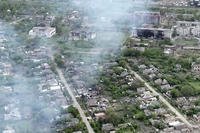The Defense Department on Monday released an updated policy for countering weapons of mass destruction (WMD) that focused on prevention, partnering with allies and demanding accurate intelligence before military action.
The new “Strategy for Countering Weapons of Mass Destruction” differs “from some of the prior documents to allow us an increased emphasis on prevention and reducing and mitigating threats earlier,” a senior Defense official said at a Pentagon background briefing.
Military action was “a right we always preserve,” the official said, but “rather than focusing more exclusively on military options, military scenarios, it (the new policy) might be associated with crises in later phases” of risk mitigation, the official said.
One of the “prior documents” referred to was the 2006 counter-WMD document endorsed by then-Defense Secretary Donald Rumsfeld three years after the U.S. invaded Iraq, partly to eliminate WMD that was thought to be controlled by dictator Saddam Hussein. The WMD was never found.
The 2006 document also stressed intelligence collection but said “we must recognize that plans and decisions will need to be made with limited or incomplete WMD-related intelligence.”
The thrust of the new policy was to deal with the WMD threat “left of boom,” or before nuclear, chemical or biological weapons are employed the senior official said.
Another factor in the new policy was the tighter budgets that are impacting Pentagon plans across the board, the senior official said.
“In a constrained fiscal environment, we are focusing our efforts on preventing acquisition (of WMD) and countering the most likely threats,” the new policy document stated.
“Accordingly, this strategy emphasizes early action through pathway defeat, shaping the environment to dissuade actors from pursuing WMD, and cooperating with partners to achieve countering WMD goals,” the new plan said.
The new strategy did not name specific countries or regions as WMD threats. “This is a strategy, not a threat assessment,” the senior official said.
However, the senior official said that the policy was “consistent” with the agreement that resulted in the turnover by Syria of its chemical weapons to international monitors. The last of Syria’s chemical weapons were removed last week and were to be destroyed aboard the specially-outfitted U.S. ship Cape Ray.
"I feel that our effort -- and the entire effort -- to eliminate Syria's declared chemical weapons stockpile is consistent from this (strategy)," the senior official said. "We've taken the ideas as we've been developing the strategy, and we've been applying it to the Syria problem.”








